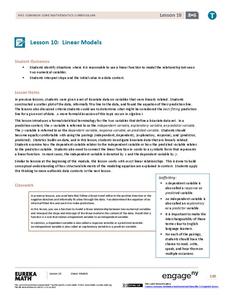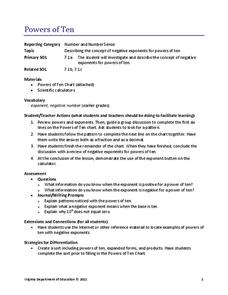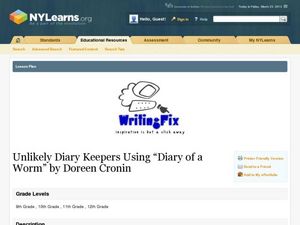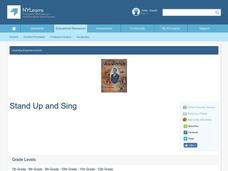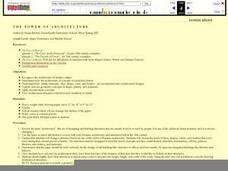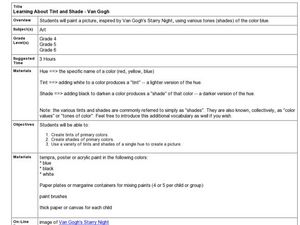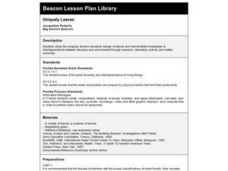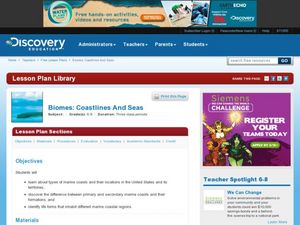EngageNY
Linear Models
Expand your pupils' vocabulary! Learn how to use statistical vocabulary regarding linear models. The lesson teaches scholars the appropriate terminology for bivariate data analysis. To complete the module, individuals use linear...
EngageNY
Negative Exponents and the Laws of Exponents
Apply the properties of exponents to expressions with negative exponents. The fifth lesson in the series explains the meaning of negative exponents through an exploration of the properties taught in the previous lessons of the...
Curated OER
A Midsummer Night's Dream Acts 1-2
Blank verse, stichomythia, soliloquy, allusion, oxymoron, malaprop? Readers of A Midsummer Night’s Dream will need to know these terms to successfully complete a study guide designed for the first two acts of Shakespeare’s comedy. The...
Curated OER
Ornithology and Real World Science
Double click that mouse because you just found an amazing lesson plan! This cross-curricular Ornithology lesson plan incorporates literature, writing, reading informational text, data collection, scientific inquiry, Internet research,...
Curated OER
So Sweet
Students compare sugar levels in cereals. In this nutrition lesson, students learn how to read a nutrition facts label, predict which products will have the most sugar, discover which cereals contain the most sugar and discuss...
Curated OER
Needs of Living Things
Students discuss and explore the needs of living things. They choose to create a slide show with captions, create a web showing the needs of one Organism using KidPix. or make picture book by hand or using Microsoft Publisher.
Virginia Department of Education
Powers of Ten
Investigate negative exponents of-ten. Pupils use the pattern of increasing powers of 10 to determine negative powers of 10. The scholars write the powers in expanded and product forms and make the connection to exponents using a...
Workforce Solutions
Actions Speak Louder Than Words
A short video demonstrates the importance of non-verbal communication in the forming of first impressions. Viewers observe the facial expressions, tone of voice, body language, and appearance of job seekers in an interview, then discuss...
Curated OER
Can Young Children Distinguish Between Living and Non-living Things?
What does it mean to be living? Help your young scientists identify living and non-living things as a result of their learning through discovery. Observation of and interaction with a set of natural phenomena in their community will make...
Utah Education Network (UEN)
7th Grade Poetry: Sonnet Poem
Two sonnets provide seventh graders with examples of Shakespearean sonnets. After discussing the story of the poems and analyzing their rhyme scheme and rhythm, young poets craft a Shakespearian sonnet and share their work with two...
Curated OER
Unlikely Diary keepers Using Diary of a Worm by Doreen Cronin
Put your class in the shoes of someone - or something - else with this lesson plan, which encourages writers to keep a diary from the perspective of a living creature or an abstraction. Use Doreen Cronin's Diary of a Worm and the Six...
Curated OER
USA State Tag / Mississippi River Shuffle
Students reinforce the geographic location of the states of the U.S.A.
Curated OER
Stand Up and Sing
Learners journal and respond to the question," How does society respond to change?" They create original lyrics to their own song that reflects the context of the Progressive Era.
Curated OER
T H E P O W E R O F A R C H I T E C T U R E
Students arecognize the architecture of another culture, how the architecture of a people records their history, explore artistic elements, explore and use geometric concepts of shape, pattern, and symmetry.
Curated OER
Dino History
Students create a timeline of the times dinosaurs lived. In this dinosaur timeline lesson, students research the various periods when dinosaurs lived. Students work in groups to research the dinosaurs of a specific time...
Curated OER
USA State Tag / Mississippi River Shuffle
Students are given the opportunity to play a tag game while studing geographical sites in the U.S.A. (relative to the Mississippi River or to other geographic features you may choose).
Curated OER
Sounds Like Science- Bottle Organ
Students investigate the relationship between pitches and notes. In this musical pitches and notes lesson, students use different sized bottles, water, and sugar to demonstrate different sounds. Students create musical notes.
Curated OER
Learning about Tint and Shade- Van Gogh
Learners explore tint, hues, and shades of color. In this art and color lesson, students observe and discuss Van Gogh's artistic style. Learners mix paints to create a single hue background and add details to paint a nightscape of...
Curated OER
FLIGHT FAIR
Students conduct their personal investigations into paper airplane flight. Cooperative teams are formed, with students choosing the paper airplane design that they are most interested in building.
Curated OER
Uniquely Leaves
Fourth graders study the uniquely diverse structural design of leaves and demonstrate knowledge of interdependence between structure and environment through research, laboratory activity and written summary.
Curated OER
Biomes: Coastlines and Seas
Students study the different types of coastlines and their territories. In this marine coasts activity students identify life forms that are in the coastal regions.
Curated OER
Sand Painting Mural
Third graders design and create classroom sand painting mural which is comprised of individually designed pieces.
Curated OER
Stealing Second: History in the Making
In this Stealing Second: History in the Making lesson, young scholars evaluate the internet and newspaper as separate and credible resources. Students analyze Clemente as a baseball player and humanitarian. Young scholars create a class...
Curated OER
Remembering to Never Forget
Students discover how the history of a place or event affects one's present perceptions of that place or event. They examine the current tensions caused by the decision to make Weimar, Germany Europe's cultural capital.
